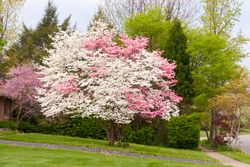3 Common Tree Diseases in Missouri

Trees are susceptible to numerous diseases that can affect their appearance and shorten their lives. To help them stay as healthy as possible, you should keep an eye out for signs of sickness and call for professional tree care when necessary. The following are some common tree diseases and the symptoms you should be aware of.
3 Common Tree Diseases & What to Look For
1. Dutch Elm Disease
Dutch elm disease, as its name suggests, affects elm trees. It is caused by a fungus spread by the elm bark beetle. Originally from Asia, the disease has spread to—and devastated—populations of trees in Europe and the Americas without any native resistance to the fungus. The name refers not to the Dutch elm hybrid species but to the fact that the disease was first identified in Europe by Dutch scientists. Look for upper branches with withered and yellowing leaves, particularly in summer. Leaf wilt then spreads to the rest of the organism, followed by branch dieback. Eventually, starved of sunlight from the lack of leaves, the roots die, and the tree must be removed. Caught in the early stages, an injectable fungicide often provides positive results.
2. Heart Rot
 In heart rot disease, fungi attack trees already weakened by damage due to over-pruning, insects, animals, or fire. It mainly affects birch, cedar, dogwood, and maple species. It spreads unseen within the heart of the tree, so it can be challenging to diagnose. Regularly check trunks for rotting spots and look for knots or other areas where you can peer inside the trunk. Use a flashlight and look for white, feathery fungus. A large mushroom may "conk" or sprout on the outside bark at the infection site. Heart rot results in foundational weakness, so preventive treatment is most effective. Keep the tree healthy, do not over-prune, remove damaged sections immediately, and have any suspect trees inspected for integrity by a tree care professional.
In heart rot disease, fungi attack trees already weakened by damage due to over-pruning, insects, animals, or fire. It mainly affects birch, cedar, dogwood, and maple species. It spreads unseen within the heart of the tree, so it can be challenging to diagnose. Regularly check trunks for rotting spots and look for knots or other areas where you can peer inside the trunk. Use a flashlight and look for white, feathery fungus. A large mushroom may "conk" or sprout on the outside bark at the infection site. Heart rot results in foundational weakness, so preventive treatment is most effective. Keep the tree healthy, do not over-prune, remove damaged sections immediately, and have any suspect trees inspected for integrity by a tree care professional.
3. Dothistroma Needle Blight
Another fungal disease, Dothistroma needle blight, affects more than 35 pine tree species throughout North America. Most susceptible are Austrian, lodgepole, Monterey, and ponderosa pines. It causes mature trees to lose needles prematurely, while it can destroy younger trees. Be alert for yellowish or tan bands appearing on the needles, followed by defoliation. If you notice symptoms, have the tree sprayed with a fungicide to prevent new needles from becoming infected. Treatment must be performed for multiple seasons to see results.
If you spot any of the signs mentioned above and need professional tree care, contact Going Green Lawn Services LLC in Fenton, MO. They are family-owned and -operated and have served St. Louis County for more than 10 years. They offer tree and lawn care, weed control, lawn mowing, irrigation, and fertilization to help your outdoor spaces stay healthy and attractive. Learn more about them on their website, or call (636) 388-2883 to schedule tree care service.
About the Business
(3 reviews)
Have a question? Ask the experts!
Send your question

